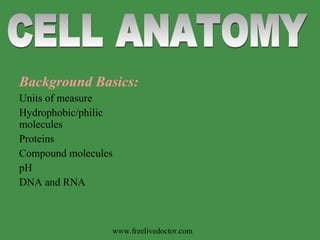Recommended
Recommended
More Related Content
What's hot
What's hot (20)
Similar to Cell Anatomy
Similar to Cell Anatomy (20)
Physiology of Cell, Tissues, Membranes and Glands.ppt

Physiology of Cell, Tissues, Membranes and Glands.ppt
A Deeper Study Into Cell Parts, Processes and Substances

A Deeper Study Into Cell Parts, Processes and Substances
More from raj kumar
More from raj kumar (20)
Cell Anatomy
- 1. Background Basics: Units of measure Hydrophobic/philic molecules Proteins Compound molecules pH DNA and RNA CELL ANATOMY www.freelivedoctor.com
- 13. RER & SER RER: Protein synthesis, strage, modification & transport vesicles SER: Synthesis and conversion of FA, steroids, lipids In muscle: Ca 2+ storage
- 23. Movement of substances across tight and leaky epithelia
- 29. Running Problem: The Pap Smear
- 30. Cervical cells. Uniform in size and shape normal
Editor's Notes
- 1
- 2
- 7 Cell shape Positioning of organelles Intracellular “railroad track” Link to EC and other cells Movement
- 10
- 8
- 5 Tay-Sachs disease is a fatal genetic disorder in which harmful quantities of a fatty substance called ganglioside GM2 accumulate in the nerve cells in the brain. Infants with Tay-Sachs disease appear to develop normally for the first few months of life. Then, as nerve cells become distended with fatty material, a relentless deterioration of mental and physical abilities occurs. The child becomes blind, deaf, and unable to swallow. Muscles begin to atrophy and paralysis sets in. A much rarer form of the disorder which occurs in patients in their twenties and early thirties is characterized by unsteadiness of gait and progressive neurological deterioration. Patients with Tay-Sachs have a "cherry-red" spot in the back of their eyes. The condition is caused by insufficient activity of an enzyme called hexosaminidase A that catalyzes the biodegradation of acidic fatty materials known as gangliosides. Gangliosides are made and biodegraded rapidly in early life as the brain develops. Patients and carriers of Tay-Sachs disease can be identified by a simple blood test that measures hexosaminidase A activity. Both parents must be carriers in order to have an affected child. When both parents are found to carry a genetic mutation in hexosaminidase A, there is a 25 percent chance with each pregnancy that the child will be affected with Tay-Sachs disease. Prenatal monitoring of pregnancies is available if desired.
- The Luxol fast blue stain highlights the large swollen neurons in Tay-Sachs disease.
- 6 Peroxisomes seem to be to be self-replicating. They don’t come off the Golgi apparatus as secretory vesicles as originally thought.
- 11 12
- CAM = cell adhesion molecule Cadherins are Calcium dependant cell adhesion molecules. They play an important role in embryonic morphogenesis and the formation of solid tissues.
- 16 19
